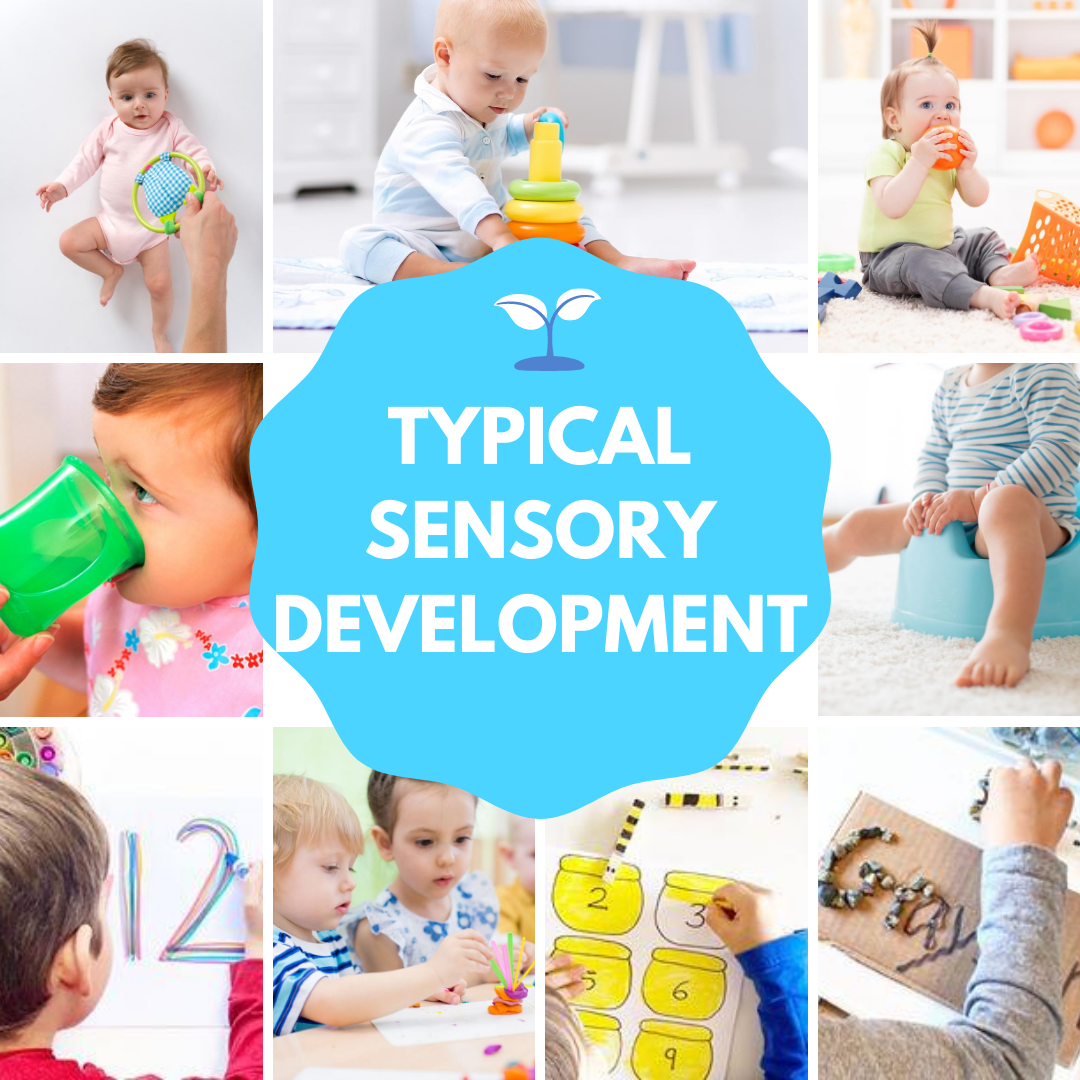
WHAT IS TYPICAL SENSORY DEVELOPMENT?
Share

At age 0-6 months, the developmental milestones of a typical child include recognizing the scent of mother’s breast milk, tracking objects with their eyes, responding to sounds/voices and reaching for nearby objects. At this age, the typically developing child is actively coordinating the suck, swallow, breathe sequence and cries to communicate hunger, fear or discomfort. If these milestones are not achieved, possible implications may include difficulties breast feeding, settling to sleep and colic.

At age 6-12 months, the developmental milestones of a typical child include playing with a single toy and imitating gestures. Children are able to drink from a cup and can sleep 6-8 hours. Typically developing children use their tongues to move food around their mouths and will tolerate a range of food textures, tastes and smells. They also open their mouths when wanting to be fed. If these milestones are not achieved, possible implications may include issues with food textures, colic, difficulty socializing with parents and other caregivers, struggling to copy and learn from others due to poor understanding and attention.

At age 1-2 years, the developmental milestones of a typical child include the ability to distinguish between edible and inedible objects and the understanding of the word danger. At this age, they are bothered by soiled underwear, react to extreme temperatures and enjoy messy play. Typically developing children are able to follow 1 step instructions, solve problems using trial and error and can look for objects that fall out of sight. If these milestones are not achieved, possible implications may include issues in social settings, struggling to copy and learn from others- due to poor understanding and attention-, delayed play skills and colic.

At age 2-3 years, the developmental milestones of a typical child include an increase in awareness and overall independence. They are learning social cues, how to take turns and find joy in exploring their surroundings both inside and outside of the home. If these milestones are not achieved, possible implications may include having trouble socializing with peers, struggling to copy and learn from others- due to poor understanding and attention- and having difficulty following instructions at home. They also may demonstrate delayed play skills, have difficulties with toilet training and exhibit feeding challenges (picky eater).

At age 3-4 years the developmental milestones of a typical child include an increase in cognitive ability. The child can identify colors and simple patters, count to 5 unprompted, is able to differentiate between real and pretend, and shows positive peer relationships & interactions. At this age, typically developing children are practicing more and more independence on a daily basis.They are able to feed themselves with utensils, and can dress themselves (only requiring assistance with laces, buttons and other fasteners). If these milestones are not achieved, possible implications may include include difficulty socializing with peers, struggling to copy and learn from others due to poor understanding and attention and difficulty following instructions at home and/or the school setting. Some children may also show difficulty expressing wants, needs, thoughts and ideas.




At age 5-6 years, the developmental milestones of a typical child include an increase in cognitive and critical thinking skills. They have the ability to write numbers, letters and simple sentences, and know the difference between right and wrong. At this age, children may also begin to test the limits. They understand that people have different opinions, perspectives and expectations but will argue/reason accordingly if things do not line up with their personal agenda. Children this age can also categorize objects, identify complex patterns, identify & draw complex shapes (rhombus/diamond) and understand concepts like yesterday, today, and tomorrow . They should know (and use) decoding strategies to read simple CVC words (cat, bug, dig), sit at a desk without fidgeting, follow teacher instructions, and complete in-class assignments/projects independently or in a small group. If these milestones are not achieved, possible implications may include difficulties socializing, following instructions/rules (at home and schoo), following routines, expressing thoughts/ ideas (verbally and in writing), and focusing.

At age 6-7 years the developmental milestones of a typical child include the ability to form numbers and letters correctly, recognize the feelings of others and the willingness to take on more responsibility. Children learn to tell time and start to understand money and the concept of personal space. These children develop a longer attention span, can name months and days of the week in order and enjoy reading a book on their own. If these milestones are not achieved, possible implications may include difficulties socializing, following instructions/rules, retelling events and expressing thoughts and ideas verbally and in written form. These children have poor attention and concentration skills and have trouble responding appropriately to questions.
Sensory activities facilitate exploration and naturally encourage children to use multiple learning pathways while they play, create, investigate and explore.
Are you looking for play-based activities to further develop your child's sensory skills and goals? Do you want to develop their ability to handle certain situations efficiently and effectively? Busy Little Learners is an innovative early childhood program that follows a play-based & multi-sensory approach to teaching & learning. Our curriculum will foster your child’s self-regulation, sensory development and creativity through PLAY. Your child will create, investigate and explore through the use of bright colors, silly scents & fun textures. Sensory Together offers play-based curriculum programs, learning activities and sensory kits for a healthy sensory lifestyle and success in learning and beyond.
Reference:
Ayres, A. J. (2005/1976). Sensory integration and the child. Los Angeles: Western Psychological Services.
Parham, L. D., & Mailloux, Z. (1996). Sensory integration. In J. Case-Smith, A. S. Allen, & P. N. Pratt (Eds.), Occupational therapy for children.